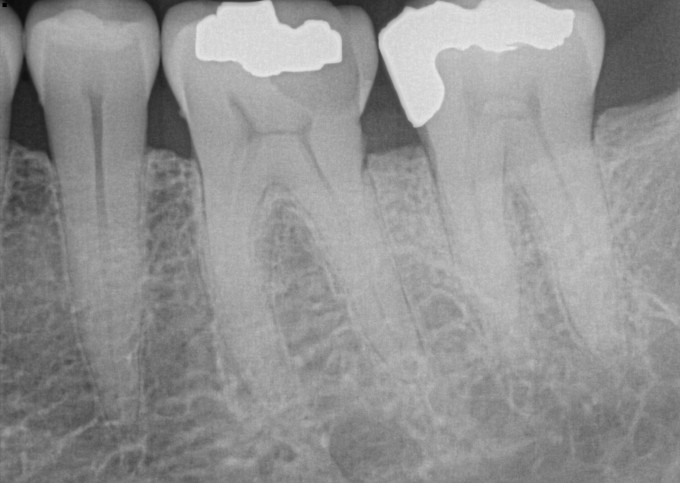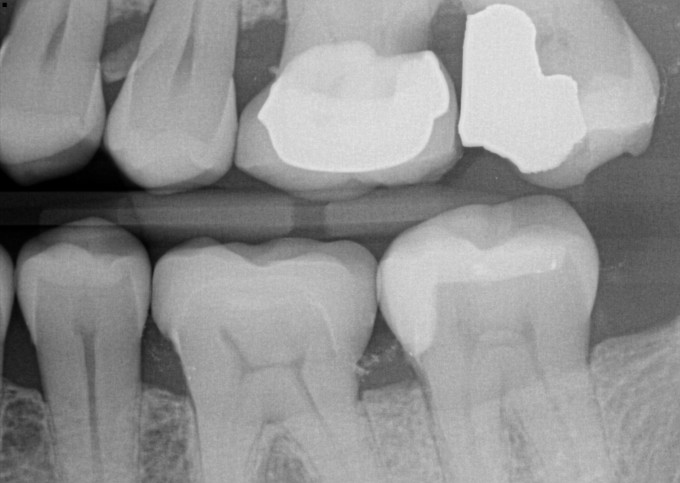Why I prefer to replace most complex Amalgams with CeraSmart inlays and onlays
This patient presented from another dental office in town needing 2 crowns. He was in attendance at a CEREC technology presentation I gave several years ago to our local Kiwanis Club and he decided that he wanted his crowns done in a single visit the CEREC way. I can post photographs later after the gingiva heals. It is obvious why I wouldn't consider allowing this dentist to provide any dental services for me. He was obviously absent for the lecture in dental school in which were presented the techniques for burnishing matrix bands to produce a proper convex inter-proximal contour for complex amalgam restorations. Or, he just doesn't give a damn, or it's the best he can do. That flat inter-proximal contour and marginal ridge only contact would have landed this guy on the bolo squad when I was in school at the University of Illinois. But he is an Iowa grad. ![]() At least he didn't leave a huge gross overhang.
At least he didn't leave a huge gross overhang. ![]() #19 had a fractured DL cusp and he was packing food, so that was his chief complaint. I insisted on replacing the poorly contoured MO amalgam on 18 because recontouring that restoration would have resulted in an over contoured distal on the crown and leaving it would not have totaly solved the food packing issue.
#19 had a fractured DL cusp and he was packing food, so that was his chief complaint. I insisted on replacing the poorly contoured MO amalgam on 18 because recontouring that restoration would have resulted in an over contoured distal on the crown and leaving it would not have totaly solved the food packing issue.
Post op bitewing, shows a little bonding resin on some soft tissue tags left over from the laser troughing. I removed most of them with a Soft-pick and the rest of them will slough. This bitewing also shows the next project, removing and replacing the PFM on #14--hopefully that decay hasn't progressed to the point where the tooth structure under the crown is totally mush. What is also obvious from the post op bitewing is that, super-tech that this other dentist is, he butchered the distal of the PFM on #14. Therefore, the mesial proximal of that amalgam is over-contoured and can be satisfactorily reshaped to provide a nice contact and eliminate the food packing in that area. Unfortunately, this patient has some pretty average, for my area, dental work. The dentist who produced this dental work needs to care less about his bottom line, and care more about the quality of the services he provides.
Why not exchange the Amalgam in 15?
Looks somehow looks a marginal ridge contact after using a non-burnished matrix band.
You will probably reduce the amalgam and recontour it to convex?
Why did you use Cerasmart and no zirconia or e.max?
On 12/9/2017 at 9:41 am, Armin Giessmann said... Why not exchange the Amalgam in 15? It was just placed 3 weeks ago, and I know I can flatten the contact.
Looks somehow loke a ridge contact after using a non-burnished matrix band. Exactly correct.
You will probably reduce the amalgam an contur it to convex? I can, at least flatten it. Insurance policy won't pay for another restoration 3 weeks after placement of this one.
Why did you use Cerasmart and no zirconia or e.max? I have stated this numerous times on this discussion board, but you are new to this website. Glass ceramics don't mill well on the super thin occlusal margins of inlays and onlays. If these glass ceramic margins do mill well without too much chipping, they will chip and the margins become ditched within a few months after placement. CeraSmart or Z100 mill very well on the thin occlusal margins of inlays, and the margins don't ditch during use. Also, the composite blocks are much easier to finish back should a margin protrude beyond the preparation margin--which can happen occasionally, especially to a less talented dentist like me. At least, when I encounter a problem, I care enough to correct it. I have more composite inlays than I can count, that have been in service for 8 or more years that look like they were placed last week. Also, given the superior performance of CeraSmart or Z100 with inlays and onlays, why would I want to use a material that requires sintering? Sintering adds a significant amount of time to these procedures, which is totally unnecessary in my opinion, given the superiority of CeraSmart or Z100 for these restorations. Also, since zirconia shrinks 25% to 30% when sintering, it doesn't make sense to use it for a restoration that must be sprued on the proximal surface. Frankly, if I have to place a sprue on the interproximal, I will never use zirconia. I don't trust that I will get an acceptable contact. If you think that eMax or zirconia would be preferable for inlays and onlays, you are fooling yourself in my opinion. I hope I have made my case.
Charles I feel as you do about the benefits of cad cam resin.
A few questions if I may -
-Is Cerasmart your favorite cad cam resin
- any breakage issues and if so when
- have you used on implants and if so how is that working out. Any issues
- are you have any issues with insurance reimbursement. How do you tend to code.
Regards,
Bruce
On 12/9/2017 at 9:30 am, Charles LoGiudice said...This patient presented from another dental office in town needing 2 crowns. He was in attendance at a CEREC technology presentation I gave several years ago to our local Kiwanis Club and he decided that he wanted his crowns done in a single visit the CEREC way. I can post photographs later after the gingiva heals. It is obvious why I wouldn't consider allowing this dentist to provide any dental services for me. He was obviously absent for the lecture in dental school in which were presented the techniques for burnishing matrix bands to produce a proper convex inter-proximal contour for complex amalgam restorations. Or, he just doesn't give a damn, or it's the best he can do. That flat inter-proximal contour and marginal ridge only contact would have landed this guy on the bolo squad when I was in school at the University of Illinois. But he is an Iowa grad.
At least he didn't leave a huge gross overhang.
#19 had a fractured DL cusp and he was packing food, so that was his chief complaint. I insisted on replacing the poorly contoured MO amalgam on 18 because recontouring that restoration would have resulted in an over contoured distal on the crown and leaving it would not have totaly solved the food packing issue.
Post op bitewing, shows a little bonding resin on some soft tissue tags left over from the laser troughing. I removed most of them with a Soft-pick and the rest of them will slough. This bitewing also shows the next project, removing and replacing the PFM on #14--hopefully that decay hasn't progressed to the point where the tooth structure under the crown is totally mush. What is also obvious from the post op bitewing is that, super-tech that this other dentist is, he butchered the distal of the PFM on #14. Therefore, the mesial proximal of that amalgam is over-contoured and can be satisfactorily reshaped to provide a nice contact and eliminate the food packing in that area. Unfortunately, this patient has some pretty average, for my area, dental work. The dentist who produced this dental work needs to care less about his bottom line, and care more about the quality of the services he provides.
Chuck, I'll say it AGAIN, your patients are fortunate to have you as their dentist!!!!
On 12/9/2017 at 10:33 am, Bruce LeBlanc said... Charles I feel as you do about the benefits of cad cam resin.
A few questions if I may -
-Is Cerasmart your favorite cad cam resin CeraSmart is my favorite composite block because it holds its original polish, and even acquires a little more luster over time. Z100 looses it's luster within a month or two.
- any breakage issues and if so when I have had one CeraSmart inlay fracture. It was an exceptionally buccally extended interproximal box that qualified as a DOF. I replaced it with a crown, which should have been done in the first place. One in ten years isn't too bad.
- have you used on implants and if so how is that working out. Any issues I have not used a resin composite material for inlays. I have a box of Enamic hybrid abutment blocks which I may try in the future.
- are you have any issues with insurance reimbursement. How do you tend to code. I have been billing insurance for the maximum percentile for direct placement composite. For large composites as I show in this thread, I not only get better results with CEREC CAD/CAM, I do them faster than direct placement. I am not good placing direct composites except in Class I, and minimally extended Class II or slot preps.
Regards,
Bruce
Bruce, Thank you for asking. I hope I have adequately answered your questions. If not, let me know and I can clarify.
@ Charles:
Haha, you are a friend of very distinct words, but I like that.
If you do not adress the problems exactly and thoroughly and anaylyse them then coming to a logical conclusion you should rather save the virtual ink. That is my opinion, too.
Many things that you pointed out sound logical to me. But still I think that there are various ways leading to Rome.
I habe my CEREC only for 2 months and cannot call myself an expert but I have had my cases and did a lot of courses and personal research.
When using conventional impressions I was a great fan of e.max over 8 years because I did not have a single case of a fracture. With empress this was sometimes an issue. I just try to get my preparation margins out of occlusion (and articulation contacts as possible). Some little ditches on the habitually clean occlusional surface seem acceptable to me since secondary caries is not an issure there normally.
But with CEREC I have had a few cases of e.max inlays already and I know that it mills badly at the edges. I guess when e.max reaches the interproximal surface or a lingual or buccal extension reaches the surface then the contour of the inlay at this point (within the tooth) should probably at least not be concave (and the prep surfqce of the tooth not convex consequently).
I will try some more by trying to defeat the shortcomings of the milling process of e.max. I am not ready to give up this material so easily after I have appreciated it for so long as e.max press.
Yes, I would never use zirconia for inlays, I was rather refering to the crown on #19.
I only trust prosthetic materials that are a long time with good results in use (my own and in literature) and that do not contain composite. (Just bad personal experiences with my own teeth with such materials.
For crowns my first choice for posteriors always is zirconia just because of it‘s stability already at thin layers. Asthetics is a problem that Katana will hopefully solve for us soon. (Does anything mill better than zirconia if milled dry?)
What I still miss is experience of milling e.max crowns. I think it will be necessary to prep not too little there and set the minimum thickness of the material in the preferences a little higher.
Mark, you are too kind. I am glad there is no audio with that video clip. Steven Colbert is one of the most despicable bottom feeding scum bags on television.
On 12/9/2017 at 11:17 am, Charles LoGiudice said...Mark, you are too kind. I am glad there is no audio with that video clip. Steven Colbert is one of the most despicable bottom feeding scum bags on television.
Not sure how you REALLY feel, Chuck!! ![]()
On 12/9/2017 at 10:53 am, Armin Giessmann said... @ Charles:
Haha, you are a friend of very distinct words, but I like that.
If you do not adress the problems exactly and thoroughly and anaylyse them then coming to a logical conclusion you should rather save the virtual ink. That is my opinion, too.
Many things that you pointed out sound logical to me. But still I think that there are various ways leading to Rome.
I habe my CEREC only for 2 months and cannot call myself an expert but I have had my cases and did a lot of courses and personal research.
When using conventional impressions I was a great fan of e.max over 8 years because I did not have a single case of a fracture. With empress this was sometimes an issue. I just try to get my preparation margins out of occlusion (and articulation contacts as possible). Some little ditches on the habitually clean occlusional surface seem acceptable to me since secondary caries is not an issure there normally.
But with CEREC I have had a few cases of e.max inlays already and I know that it mills badly at the edges. I guess when e.max reaches the interproximal surface or a lingual or buccal extension reaches the surface then the contour of the inlay at this point (within the tooth) should probably at least not be concave (and the prep surfqce of the tooth not convex consequently).
I will try some more by trying to defeat the shortcomings of the milling process of e.max. I am not ready to give up this material so easily after I have appreciated it for so long as e.max press.
Yes, I would never use zirconia for inlays, I was rather refering to the crown on #19.
I only trust prosthetic materials that are a long time with good results in use (my own and in literature) and that do not contain composite. (Just bad personal experiences with my own teeth with such materials.
For crowns my first choice for posteriors always is zirconia just because of it‘s stability already at thin layers. Asthetics is a problem that Katana will hopefully solve for us soon. (Does anything mill better than zirconia if milled dry?)
What I still miss is experience of milling e.max crowns. I think it will be necessary to prep not too little there and set the minimum thickness of the material in the preferences a little higher.
Armin,
Thank you for this dialog. I can see that your mind is made up. I shouldn't stereotype, but Germans seem to be very inflexible. ![]() We will have to agree to disagree.
We will have to agree to disagree. ![]() In my opinion, if I have access to a material that mills nearly perfect inlays and doesn't chip on the margins during service, a little ditching on the occlusal margins of glass ceramic inlays is totally unacceptable, because that is not the best I can do. I have had one e.Max fracture in 11 years. It was an upper second molar that was .7mm thick in the central groove. I haven't made that mistake again. If I have a failure, I analyze what I did wrong. I do not look to blame the material, except Celtra Duo which is a total loser, and I do not look to a material first to bail me out. Yes, an eMax inlay will likely never fracture, but a properly done, bonded CeraSmart inlay will never fracture either. In my opinion, the hardness of eMax is a detriment for inlays, because that much strength is not needed, but the hardness makes any finishing that may be needed extremely difficult. For posterior crowns, my first choice of material is eMax. Currently I am using zirconia when I don't think I can successfully bond a restoration, or when I absolutely can't get at least 1mm of thickness in the central groove. The translucency of Katana ultra translucent zirconia is similar to that of eMax LT. That is not sufficient translucency in the anterior, but it is ok in the posterior. But the modulus of elasticity is only about 700 mpa, compared to 500 mpa for eMax. Since eMax doesn't fracture when properly done, of what use is the extra 200 mpa, except when 1mm of occlusal thickness can't be achieved? (which is very seldom). If you ever get to Scottsdale, AZ or Charlotte, NC and I am mentoring, we can go to dinner and butt heads. We Sicilians can be as stubborn and inflexible as you Germans.
In my opinion, if I have access to a material that mills nearly perfect inlays and doesn't chip on the margins during service, a little ditching on the occlusal margins of glass ceramic inlays is totally unacceptable, because that is not the best I can do. I have had one e.Max fracture in 11 years. It was an upper second molar that was .7mm thick in the central groove. I haven't made that mistake again. If I have a failure, I analyze what I did wrong. I do not look to blame the material, except Celtra Duo which is a total loser, and I do not look to a material first to bail me out. Yes, an eMax inlay will likely never fracture, but a properly done, bonded CeraSmart inlay will never fracture either. In my opinion, the hardness of eMax is a detriment for inlays, because that much strength is not needed, but the hardness makes any finishing that may be needed extremely difficult. For posterior crowns, my first choice of material is eMax. Currently I am using zirconia when I don't think I can successfully bond a restoration, or when I absolutely can't get at least 1mm of thickness in the central groove. The translucency of Katana ultra translucent zirconia is similar to that of eMax LT. That is not sufficient translucency in the anterior, but it is ok in the posterior. But the modulus of elasticity is only about 700 mpa, compared to 500 mpa for eMax. Since eMax doesn't fracture when properly done, of what use is the extra 200 mpa, except when 1mm of occlusal thickness can't be achieved? (which is very seldom). If you ever get to Scottsdale, AZ or Charlotte, NC and I am mentoring, we can go to dinner and butt heads. We Sicilians can be as stubborn and inflexible as you Germans. ![]()
Hey Charles,
tx for the first good extensive dialogue that I have here. I think my stubborness is not typically German but typically me in some matters.
Don‘t worry. I did not take your remark too serious.
It looks like a loose piece of RelyX Ultimate that didn't get vacuumed up. It wouldn't be anything else.
Great looking Cerasmart restorations. Is there caries under distal margin of upper molar crown opposing your restorations (tooth 2-6)?
On 12/9/2017 at 8:50 pm, Nassim Missaghian said...Great looking Cerasmart restorations. Is there caries under distal margin of upper molar crown opposing your restorations (tooth 2-6)?
Yes, that is caries. I did mention in my narrative that replacing the crown on #14 (#26 in International notation) and treating the caries will be our next project. The patient's chief complaint was a fractured DL cusp on #19 and food packing between 19 and 18. He was unaware of the caries under the distal margin of #14. Interestingly enough, when #19 was prepared for a crown, I found a small carious lesion below the CEJ of #19 and it wasn't showing up in any of the radiographs. That made for a very subgingival distal margin for the #19 eMax CAD crown.
Ah, #19 is e.max, not CeraSmart.
As can be seen by the different degree of x-ray translucency that I did not bother to focus on after having read „CeraSmart“.
How did you keep the distal margin dry and free from blood when insertig the crown?
Thanks Charles for detailed answer.
Regarding billing for cad cam resin restorations for insurance reimbursements often the payment for large composite would be very low like an amalgam. To me low insurance payment is hindering the use of these great materials by clinicians who then opt to porcelain for better reimbursement which is unfortunate but reality. Since the intro of 3m ultimate some would make claim as a ceramic based on zirconium filler. Are you hearing those conversations. I am trying to solve the dilemma for the profession to get properly reimbursed for these great restorations. I feel like you resin can be the ideal chair side material for many reasons.
Thanks,
Bruce
Armin,
This entire case was done with an Isolite in place. The tissue between 18 and 19 was treated with 3M Retraction Paste for 2 minutes because the inlay was bonded in place and the retraction paste squeeze-out from that was cleaned up first. That stimulated some fresh bleeding. I have two milling chambers. It is not possible to start two restorations milling at the same time. They have to be sent to the respective milling chambers sequentially. But it is possible to have two restorations milling simultaneously. That saves a little time. I have a Sirolaser diode laser in my CEREC operatory and I can always obtain a bloodless field using a combination of the Sirolaser and 3M Retraction Paste. If the hemorrhage isn't too bad I use Viscostat Clear (no Ferric Sulfate) instead of 3M Retraction Paste. PS. My wife and I visited Germany in 2013 with a group of cerecdoctors.com Mentors. At my age, 71, it is unlikely I will return. There are too many other places we haven't visited.
Excellent execution and brilliant explanation of why! This patient was so fortunate to make the switch and have you restore those teeth. I am also a big fan of Cerasmart for replacing the large complex amalgams. Thanks for sharing your case!
Bruce,
Many Colleagues probably want to crucify me for this, but I bill insurance for standard direct placed composite. My reason is that most of the patients I see need multiple restorations and a couple of $500 inlays will max them out and they all refuse to "pay for anything I don't have to pay for." At my age I am treating dentistry partly as my hobby. I am paying the bills and I am profitable, thanks to CEREC. My primary goal is quality, not money.
Charles,
Isolite = rubber dam?
Do you like the retraction paste? Thought of buying it.
I use comprecaps over cords.
I keep my Sirolaser Blue in the background.
You got a second mill? Are you good at negotiations? „I buy one and get one free.“?
Armin,
Isolite does not equal rubber dam. However, I find rubber dam pretty useless when subgingival margins are involved. When dealing with subgingival margins, I find that an Isolite is the best option for me. I like 3M Retraction paste and I use it when hemorrhage is difficult to control. The drawback to 3M Retraction paste is that cleanup is difficult. It must be cleaned up with an aggressive air & water spray. That can sometimes get the hemorrhage going again. I use cord occasionally. I find it useful if the sulcus is not too deep. When I use it I keep it in place until after the restoration is bonded because it prevents bonding resin from going subgingival and it makes bonding resin clean up easier--remove the cord, and remove much of the bonding resin squeeze-out. The much improved margin imaging in version 4.5.2 has made using cord and leaving it in the sulcus for resin cleanup a much better option. I have never used Comprecaps but I know they work. If there is a drawback to Comprecaps, it would be that they must be removed for imaging and they don't help with resin cleanup. However, many bonding resins are easier to clean up than the Scotchbond Universal/RelyX Ultimate I use. I can only share my story about how I acquired my Dry Mill Practice Lab and Speedfire oven if I am speaking directly to you.
Thanks Charles.
It is admirable you help your patients in this way.
I just feel for the profession as a whole and those who require an appropriate profit margin there has to be some way to have insurance pay for this appropriately.
Does anyone reading this have other suggestions.
Thanks again Charles,
Bruce
Personal preference. Enamic is the worst material for holding it's luster after polishing, and the polish on it is terrible to begin with. It mills fast with great margins. Also, the debonds I got with Enamic when I tried it for full contour crowns turned me off to it. I have had no debonds with Enamic inlays and onlays--I have placed a few. The polishing issue is my reason for preferring CersSmart. I will add a funny story. I placed a debonded Enamic crown in my Programat CS to burn out the bonding resin. I forgot that it was Enamic. Needless to say, the bonding resin wasn't the only substance that was reduced to ash.
Charles,
ok, I thought that Isolite is someting you use in addition to the retraction paste.
One of my assistants once worked in a practice where they used it.
And it was recommended in an CEREC course I just took.
that made me curious.
Equally to with e.max I still stick to my old methods that I used with Impregum impressions.
My tissue managment usually was to lay one round of (chemicalized) cord in the sulcus and lay several rounds of cords over this one and then let the patient exert pressure on this using the Comprecap by biting on this. Usually for seven minutes.
The great physical pressure retracted the gingiva usually well and in 95% of the cases the hemorrhage stopped, too, also due to the chemical (aluminum based, and sometimes Hydrogenperoxid in addition, manually added, forbidden, of course for immediate adhesive bonding).
The bleeding stops for quite a time with this method and therefore I transfered it to CEREC. Quite successful so far.
But this method takes a lot of time and placing the cord is not always easy, so might try the paste. What I miss about it is the amount of pressure to force to gingiva to retreat.
Speaking directly means not messaging but having a drink together?
Armin
I only use retraction paste for bleeding. If you ever get a taste of it, you will make certain you patient won't be able to taste it.
Nice work Charles! Patient is lucky to have found you.
What is your cement spacer parameter at? I like it!
John,
My crown spacer is set at 120. I will make an editorial comment here, although it seems that nobody pays attention to what I think. In my opinion, most users attach way too much importance to parameters. For the most part, the factory presets are all we need, although I am using most of Skramy's parameters. There are no magic parameters that will miraculously turn our cases into presentation quality restorations. With some experience, most of us will tweak a parameter or two. For instance, I have found that an Occlusal Offset of -175 is not adequate and results in many occlusal adjustments for me. I use Todd Ehrlich's suggested Occlusal Offset of -225. Since I went to that, I have had almost no occlusal adjustments. Some people will reduce their Spacer to 100 when doing a crown on the most distal tooth in an arch. That having been said, the most important determinant of success in CEREC dentistry is the quality of the preparations. The reason why you don't see much of a bonding resin line under my crown is not a result of the Spacer parameter. I am currently doing all of my bonding with Scotchbond Universal/RelyX Ultimate. That particular bonding system is not super opaque. It can be seen, but it is necessary to look closely to see it.
John,
can you elaborate on how you cement inlays/onlays w cerasmart? I've seen a lot of different techniques including using flowable composites or even warmed up regular composites. where i have the most frustration is interproximal box floors and inlays/onlay cement/flowable removal.
appreciate your regular contributions to this forum.
thanks
Bill
On 1/25/2018 at 8:58 am, Bill Argersinger said... John,
can you elaborate on how you cement inlays/onlays w cerasmart? I've seen a lot of different techniques including using flowable composites or even warmed up regular composites. where i have the most frustration is interproximal box floors and inlays/onlay cement/flowable removal.
appreciate your regular contributions to this forum.
thanks
Bill
Bill, when I bond anything, I place the thickest cord I can get in the sulcus. Usually a #2. i soak the cord in Viscostat clear and pack it so it is just below the edge of the margin and not impinging over it to inhibit seating of the onlay. Place some blue sep on the interproximal of the inlay and the adjacent tooth. it is a separating medium where nothing will stick to it. allows for easy clean up, just dont get it on your margin because it will inhibit the bond. I use a dual cure cement. you can tack cure it quickly, or you can also wait about 90 seconds to 2 minutes and let it get to get stage. if you tack it, peel off the gel set layer. hold down the onlay with a plugger and floss the restoration. once you can get floss through, cure the interproximal again on the B and L for 5 seconds or so. Take a soft pick from the Butler GUM company and push it through the interproximal to remove the excess cement. the large cord will not allow the cement to go subgingival and the soft pick takes out the majority and whatever gets stuck to the cord comes with it when you pull it out. then just take a scaler to get any excess cement off. there should not be much.

















